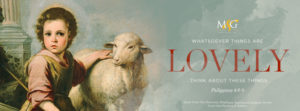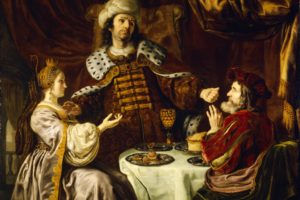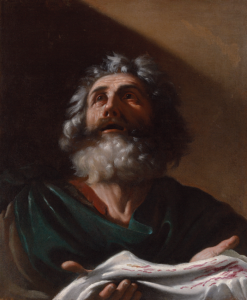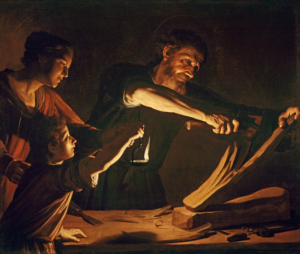The Adoration of the Shepherds
Oil on canvas
Jacques Stella
French, 1596–1657
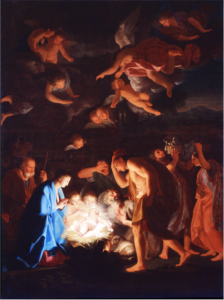
Sometimes it isn’t what you know, it’s who you know.
Jacques Stella travelled to Florence, Italy, and worked for Cosimo II de’ Medici, Grand Duke of Tuscany. Returning to France, Stella became official painter to Cardinal Richelieu and then Painter to the King (Louis XIII). But these powerful historic personages do not impact his work Adoration of the Shepherds.
Likely inspired by a prototype by Correggio, the first Italian to introduce the supernatural light emanating from Christ and illuminating the nocturnal scene1, Stella has one of the shepherds shield his eyes, foreshadowing Christ’s declaration of Himself as the “light of the world.” But it is not even this master of Italian art that figures most prominently in Stella’s painting.
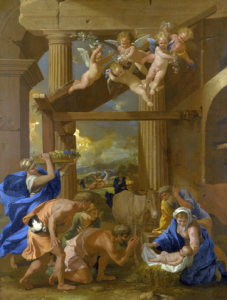 Rather, it is his lifelong friend and fellow painter Nicolas Poussin whom he met during his 10 years in Rome between his service to the Duke and the Cardinal. Their similar works Adoration of the Shepherds reveal their friendship and knowledge of each other’s art.
Rather, it is his lifelong friend and fellow painter Nicolas Poussin whom he met during his 10 years in Rome between his service to the Duke and the Cardinal. Their similar works Adoration of the Shepherds reveal their friendship and knowledge of each other’s art.
Stella’s Adoration contains the obligatory elements in the lower half. But the viewer must read the upper half through the iconography of the lower. Mary, robed in blue, prays; Joseph kneels; and the shepherds wonder. Christ lies in the manger on a white cloth which outlines his extended left hand which, in turn, points directly at a resting lamb. Surprisingly, the baby is not “wrapped in swaddling clothes” (Luke 2:12). He is only diapered. On the far right two figures bear a basket containing two doves, an oddity until one remembers that the temple sacrifice to redeem the firstborn of a poor family was two turtledoves.
In these three ways Stella points to Christ as the Savior of the world: His identification as the Lamb of God, the necessity of a sacrifice for redemption, and the hinted-at burial shroud on which He’s resting.
So far, so good. But in the upper area are both angels and putti. The biblical account clearly states that the angels “had gone away from [the shepherds] into heaven” (Luke 2:15), so these figures show definite artistic license. In the air above his Holy Family, Nicolas Poussin also has putti; his are strewing flowers, a seemingly joyous gesture. However, the flowers are iconographic “flores of martyrum”2; these putti represent the Holy Innocents who by the hand of Herod will be the first martyrs for Christ. Though Stella does not include flowers, clearly his putti also represent the Holy Innocents—given the intimations of Christ’s own martyrdom and the sacrificial doves, classic symbols of innocence.
Stella blends the halves of the work in three significant ways. The two putti gathered around the manger connect the worlds of heavenly bliss and earthly suffering. In addition, the sightline of the front dove-bearer looks heavenward past the basket, connecting the sacrificial doves to the now-redeemed children. The mountain seen on the right also connects the two worlds. Surely here is Mt. Moriah, where Abraham was to sacrifice Isaac, the innocent child of promise, but was stopped by God who provided “himself a lamb” (Genesis 22:8); and where the Lamb of God would sacrifice Himself, the innocent dying for the guilty, to make heaven possible for fallen mankind.
Jacques Stella, like his friend Nicolas Poussin, tells more than the Christmas story: there is none innocent enough for heaven without the redeeming death of the sinless Son of God. It’s not what you know, it’s Who.
Karen Rowe Jones, M&G Board Member
Footnotes:
1David Steel Jr., Baroque Paintings from the Bob Jones University Collection, Exhibition catalogue (Raleigh: North Carolina Museum of Art, 1984), 22.
2De Grazia, Diane. “Poussin’s ‘Holy Family on the Steps’ in Context.” Cleveland Studies in the History of Art 4 (1999): 26–63.
Published 2021
